Paper Menu >>
Journal Menu >>
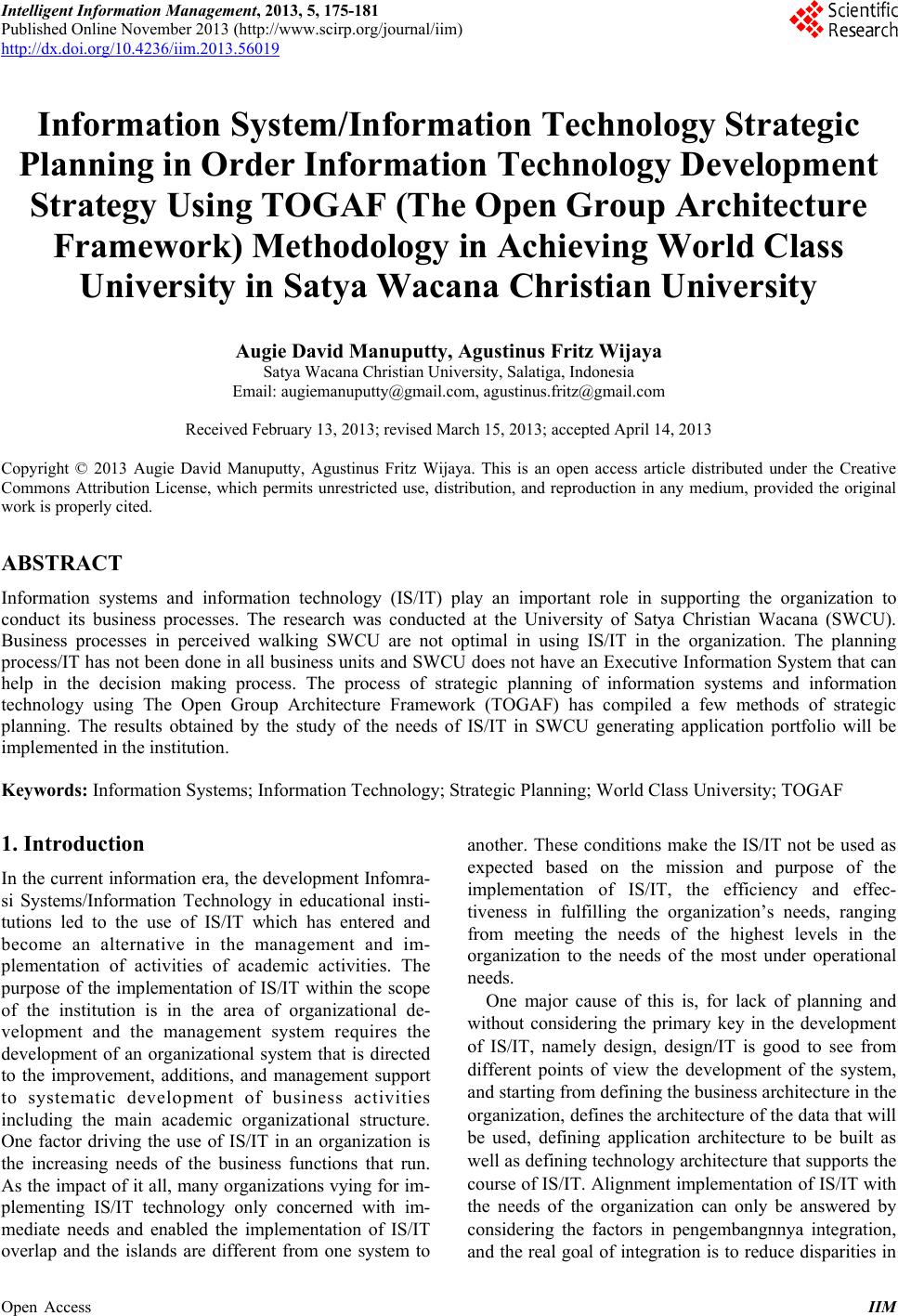 Intelligent Information Management, 2013, 5, 175-181 Published Online November 2013 (http://www.scirp.org/journal/iim) http://dx.doi.org/10.4236/iim.2013.56019 Open Access IIM Information System/Information Technology Strategic Planning in Order Information Technology Development Strategy Using TOGAF (The Open Group Architecture Framework) Methodol ogy in Achievi n g World Class University in Satya Wacana Christian University Augie David Manuputty, Agustinus Fritz Wijaya Satya Wacana Christian University, Salatiga, Indonesia Email: augiemanuputty@gmail.com, agustinus.fritz@gmail.com Received February 13, 2013; revised March 15, 2013; accepted April 14, 2013 Copyright © 2013 Augie David Manuputty, Agustinus Fritz Wijaya. This is an open access article distributed under the Creative Commons Attribution License, which permits unrestricted use, distribution, and reproduction in any medium, provided the original work is properly cited. ABSTRACT Information systems and information technology (IS/IT) play an important role in supporting the organization to conduct its business processes. The research was conducted at the University of Satya Christian Wacana (SWCU). Business processes in perceived walking SWCU are not optimal in using IS/IT in the organization. The planning process/IT has not been done in all business units and SWCU does not have an Executive Information System that can help in the decision making process. The process of strategic planning of information systems and information technology using The Open Group Architecture Framework (TOGAF) has compiled a few methods of strategic planning. The results obtained by the study of the needs of IS/IT in SWCU generating application portfolio will be implemented in the in stitution. Keywords: Information Systems; Information Technology; Strategic Planning; World Class University; TOGAF 1. Introduction In the current information era, the development Infomra- si Systems/Information Technology in educational insti- tutions led to the use of IS/IT which has entered and become an alternative in the management and im- plementation of activities of academic activities. The purpose of the implementation of IS/IT within the scope of the institution is in the area of organizational de- velopment and the management system requires the development of an organizational system that is directed to the improvement, additions, and management support to systematic development of business activities including the main academic organizational structure. One factor driving the use of IS/IT in an organization is the increasing needs of the business functions that run. As the impact of it all, many organizations vying for im- plementing IS/IT technology only concerned with im- mediate needs and enabled the implementation of IS/IT overlap and the islands are different from one system to another. These conditions make the IS/IT not be used as expected based on the mission and purpose of the implementation of IS/IT, the efficiency and effec- tiveness in fulfilling the organization’s needs, ranging from meeting the needs of the highest levels in the organization to the needs of the most under operational needs. One major cause of this is, for lack of planning and without considering the primary key in the development of IS/IT, namely design, design/IT is good to see from different points of view the development of the system, and starting from defining the business architecture in the organization, defines the architectur e of the data that will be used, defining application architecture to be built as well as defining technology architecture that supports the course of IS/IT. Alignment implementation of IS/IT with the needs of the organization can only be answered by considering the factors in pengembangnnya integration, and the real goal of integration is to reduce disparities in 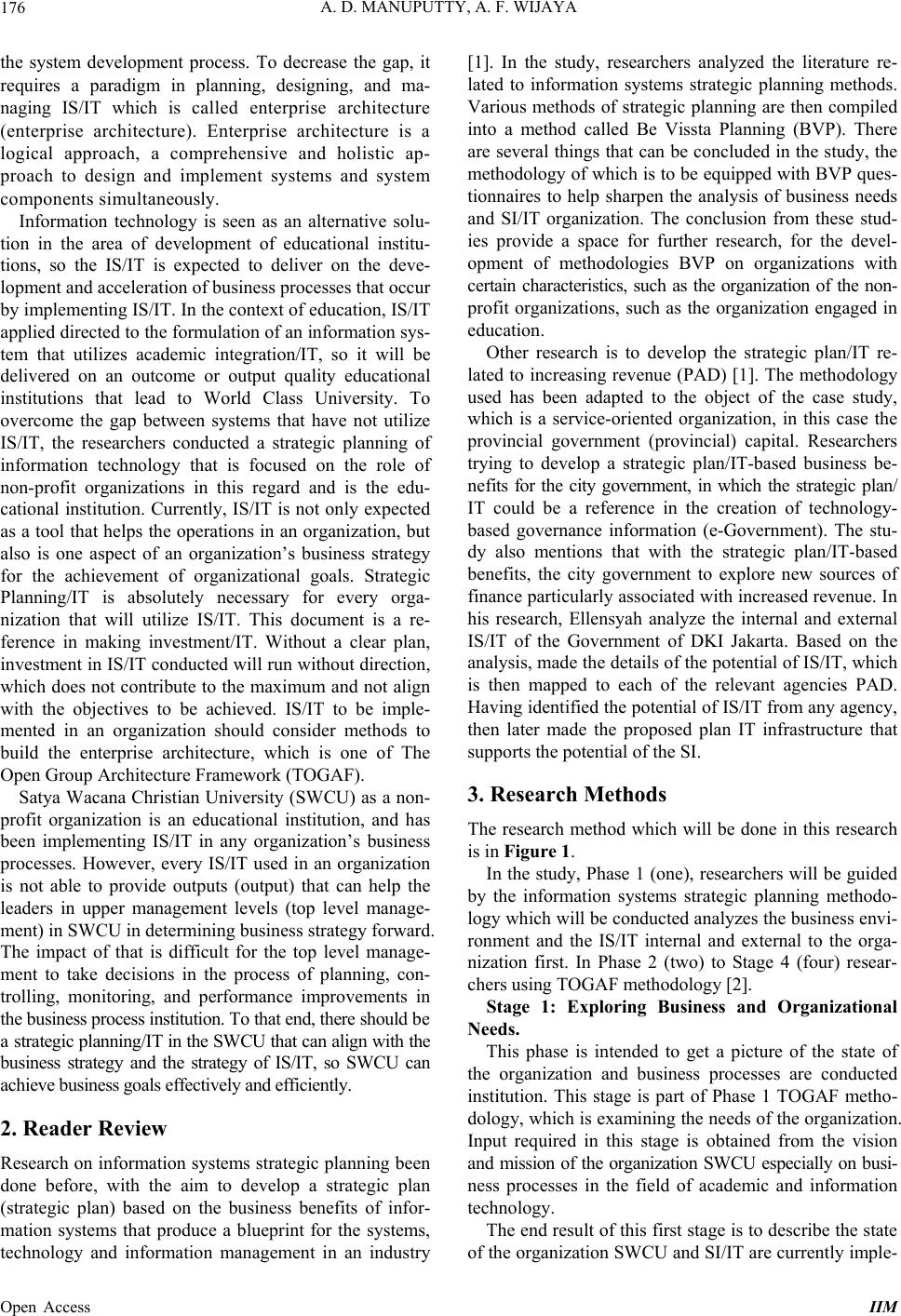 A. D. MANUPUTTY, A. F. WIJAYA Open Access IIM 176 the system development process. To decrease the gap, it requires a paradigm in planning, designing, and ma- naging IS/IT which is called enterprise architecture (enterprise architecture). Enterprise architecture is a logical approach, a comprehensive and holistic ap- proach to design and implement systems and system components simultaneously. Information technology is seen as an alternative solu- tion in the area of development of educational institu- tions, so the IS/IT is expected to deliver on the deve- lopment and acceleration of business processes that occur by implementing IS/IT. In the context of educatio n, IS/IT applied directed to the formulation of an information sys- tem that utilizes academic integration/IT, so it will be delivered on an outcome or output quality educational institutions that lead to World Class University. To overcome the gap between systems that have not utilize IS/IT, the researchers conducted a strategic planning of information technology that is focused on the role of non-profit organizations in this regard and is the edu- cational institution. Currently, IS/IT is not only expected as a tool that helps the operations in an organization, but also is one aspect of an organization’s business strategy for the achievement of organizational goals. Strategic Planning/IT is absolutely necessary for every orga- nization that will utilize IS/IT. This document is a re- ference in making investment/IT. Without a clear plan, investment in IS/IT conducted will run without direction, which does not contribute to the maximum and not align with the objectives to be achieved. IS/IT to be imple- mented in an organization should consider methods to build the enterprise architecture, which is one of The Open Group Architecture Framework (TOGAF). Satya Wacana Christian University (SWCU) as a non- profit organization is an educational institution, and has been implementing IS/IT in any organization’s business processes. However, every IS/IT used in an organization is not able to provide outputs (output) that can help the leaders in upper management levels (top level manage- ment) in SWCU in determining business strategy forward. The impact of that is difficult for the top level manage- ment to take decisions in the process of planning, con- trolling, monitoring, and performance improvements in the business process institution. To that end, there should be a str ategi c plan ning /IT in the SWCU that c an al ign w ith the business strategy and the strategy of IS/IT, so SWCU can achieve business goals effectively and efficiently. 2. Reader Review Research on information systems strategic planning been done before, with the aim to develop a strategic plan (strategic plan) based on the business benefits of infor- mation systems that produce a blueprint for the systems, technology and information management in an industry [1]. In the study, researchers analyzed the literature re- lated to information systems strategic planning methods. Various methods of strategic planning are then compiled into a method called Be Vissta Planning (BVP). There are several things that can be concluded in the study, the methodology of which is to be equipped with BVP ques- tionnaires to help sharpen the analysis of business needs and SI/IT organization. The conclusion from these stud- ies provide a space for further research, for the devel- opment of methodologies BVP on organizations with certain characteristics, such as the organization of the non- profit organizations, such as the organization engaged in education. Other research is to develop the strategic plan/IT re- lated to increasing revenue (PAD) [1]. The methodology used has been adapted to the object of the case study, which is a service-oriented organization, in this case the provincial government (provincial) capital. Researchers trying to develop a strategic plan/IT-based business be- nefits for the city government, in which the strategic plan/ IT could be a reference in the creation of technology- based governance information (e-Government). The stu- dy also mentions that with the strategic plan/IT-based benefits, the city government to explore new sources of finance particularly associated with increased revenue. In his research, Ellensyah analyze the internal and external IS/IT of the Government of DKI Jakarta. Based on the analysis, made the details of the poten tial of IS/IT, which is then mapped to each of the relevant agencies PAD. Having identified the potential of IS/IT from any agency, then later made the proposed plan IT infrastructure that supports the potential of the SI. 3. Research Methods The research method which will be done in this research is in Figure 1. In the study, Phase 1 (one), researchers will be guided by the information systems strategic planning methodo- logy which will be conducted analyzes the business envi- ronment and the IS/IT internal and external to the orga- nization first. In Phase 2 (two) to Stage 4 (four) resear- chers using TOGAF methodology [2]. Stage 1: Exploring Business and Organizational Needs. This phase is intended to get a picture of the state of the organization and business processes are conducted institution. This stage is part of Phase 1 TOGAF metho- dology, which is examining the needs of the organization. Input required in this stage is obtained from the vision and mission of the organization SWCU especially on busi- ness processes in the field of academic and information technology. The end result of this first stage is to describe the state of the organization SWCU and SI/IT are currently imple- 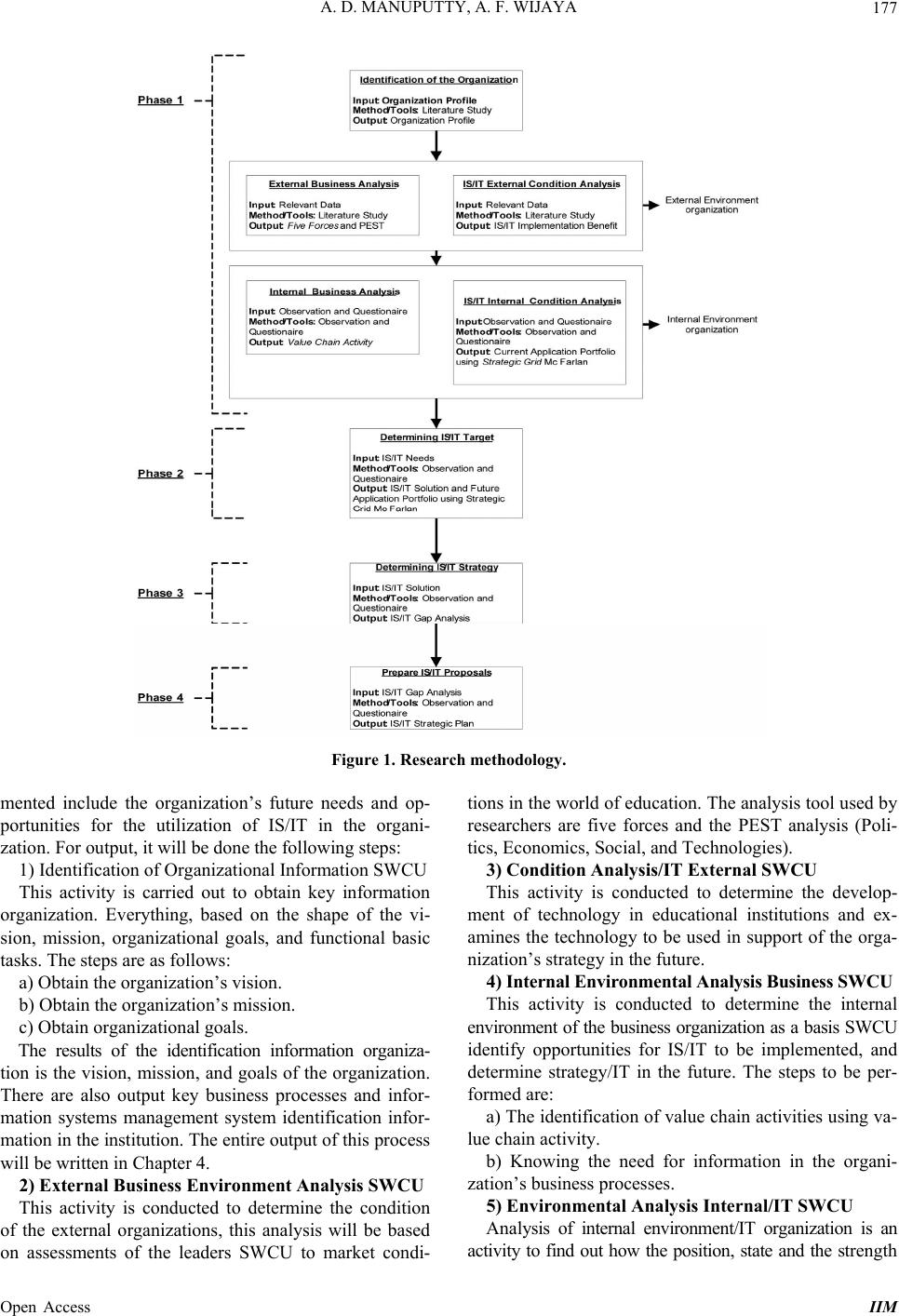 A. D. MANUPUTTY, A. F. WIJAYA Open Access IIM 177 Figure 1. Research methodology. mented include the organization’s future needs and op- portunities for the utilization of IS/IT in the organi- zation. For output, it will be done the following steps: 1) Identification of Organizational Information SWCU This activity is carried out to obtain key information organization. Everything, based on the shape of the vi- sion, mission, organizational goals, and functional basic tasks. The steps are as follows: a) Obtain the organization’s vision. b) Obtain the organization’s mission. c) Obtain organizational goals. The results of the identification information organiza- tion is the vision, mission, and goals of the organization. There are also output key business processes and infor- mation systems management system identification infor- mation in the institution. Th e entire output of this pro cess will be written in Chapter 4. 2) External Business Environment Analysis SWCU This activity is conducted to determine the condition of the external organizations, this analysis will be based on assessments of the leaders SWCU to market condi- tions in the world of education. The analysis tool used by researchers are five forces and the PEST analysis (Poli- tics, Economics, Social, and Technologies). 3) Condition Analysis/IT External SWCU This activity is conducted to determine the develop- ment of technology in educational institutions and ex- amines the technology to be used in support of the orga- nization’s strategy in the future. 4) Internal Environmental Analysis Business SWCU This activity is conducted to determine the internal environment of the business organization as a basis SWCU identify opportunities for IS/IT to be implemented, and determine strategy/IT in the future. The steps to be per- formed are: a) The identification of value chain activities us ing va- lue chain activity. b) Knowing the need for information in the organi- zation’s business processes. 5) Environmental Analysis Internal/IT SWCU Analysis of internal environment/IT organization is an activity to find out how the position, state and the strengt h 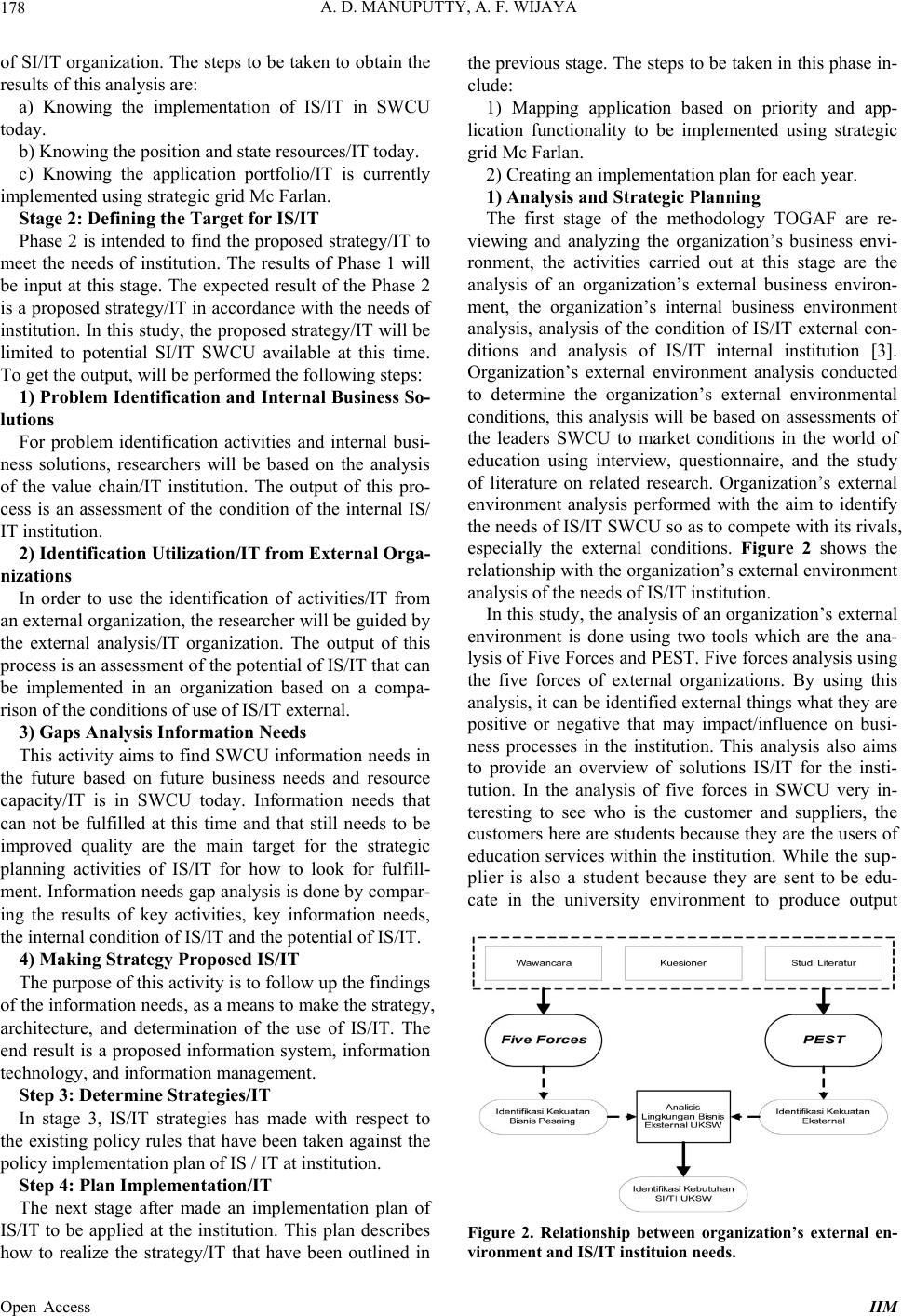 A. D. MANUPUTTY, A. F. WIJAYA Open Access IIM 178 of SI/IT organization. The steps to be taken to obtain the results of this analysis are: a) Knowing the implementation of IS/IT in SWCU today. b) Knowing the position and state resour ces/IT today. c) Knowing the application portfolio/IT is currently implemented using strategic grid Mc Farlan. Stage 2: Defining the Target for IS/IT Phase 2 is intended to find the proposed strategy/IT to meet the needs of institution. The results of Phase 1 will be input at this stage. The expected result of the Phase 2 is a proposed strategy/IT in accordance with the needs of institution. In this study, the propo sed strategy/IT will be limited to potential SI/IT SWCU available at this time. To get the output, will be performed the follow ing steps: 1) Problem Identification and Internal Business So- lutions For problem identification activities and internal busi- ness solutions, researchers will be based on the analysis of the value chain/IT institution. The output of this pro- cess is an assessment of the condition of the internal IS/ IT institution. 2) Identification Utilization/IT from External Orga- nizations In order to use the identification of activities/IT from an external organizatio n, the researcher will b e guided by the external analysis/IT organization. The output of this process is an assessment of the potential of IS/IT that can be implemented in an organization based on a compa- rison of the conditions of use of IS/IT external. 3) Gaps Analysis Information Needs This activity aims to find SWCU information needs in the future based on future business needs and resource capacity/IT is in SWCU today. Information needs that can not be fulfilled at this time and that still needs to be improved quality are the main target for the strategic planning activities of IS/IT for how to look for fulfill- ment. Information needs gap analysis is done by compar- ing the results of key activities, key information needs, the internal cond ition of IS/IT and the potential of IS/IT. 4) Making Strategy Proposed IS/IT The purpose of this activ ity is to follow up the findings of the information needs, as a means to make the strategy, architecture, and determination of the use of IS/IT. The end result is a proposed information system, information technology, and information management. Step 3: Determine Strategies/IT In stage 3, IS/IT strategies has made with respect to the existing policy rules that have been taken against the policy implementation plan of IS / IT at institution. Step 4: Plan Implementation/IT The next stage after made an implementation plan of IS/IT to be applied at the institution. This plan describes how to realize the strategy/IT that have been outlined in the previous stage. Th e steps to be taken in this phase in- clude: 1) Mapping application based on priority and app- lication functionality to be implemented using strategic grid Mc Farlan. 2) Creating an implementation plan for each year. 1) Analysis and Strategic Planning The first stage of the methodology TOGAF are re- viewing and analyzing the organization’s business envi- ronment, the activities carried out at this stage are the analysis of an organization’s external business environ- ment, the organization’s internal business environment analysis, analysis of the condition of IS/IT external con- ditions and analysis of IS/IT internal institution [3]. Organization’s external environment analysis conducted to determine the organization’s external environmental conditions, this analysis will be based on assessments of the leaders SWCU to market conditions in the world of education using interview, questionnaire, and the study of literature on related research. Organization’s external environment analysis performed with the aim to identify the needs of IS/IT SWCU so as to compete with its rivals, especially the external conditions. Figure 2 shows the relationship with the organization’s external environment analysis of the needs of IS/IT institution. In this study, the analysis of an organization’s external environment is done using two tools which are the ana- lysis of Five Forces and PEST. Five forces analysis using the five forces of external organizations. By using this analysis, it can be identified ex ternal thing s what they are positive or negative that may impact/influence on busi- ness processes in the institution. This analysis also aims to provide an overview of solutions IS/IT for the insti- tution. In the analysis of five forces in SWCU very in- teresting to see who is the customer and suppliers, the customers here are students because they are the users of education services within the institution. While th e sup- plier is also a student because they are sent to be edu- cate in the university environment to produce output Figure 2. Relationship between organization’s external en- vironment and IS/IT instituion needs. 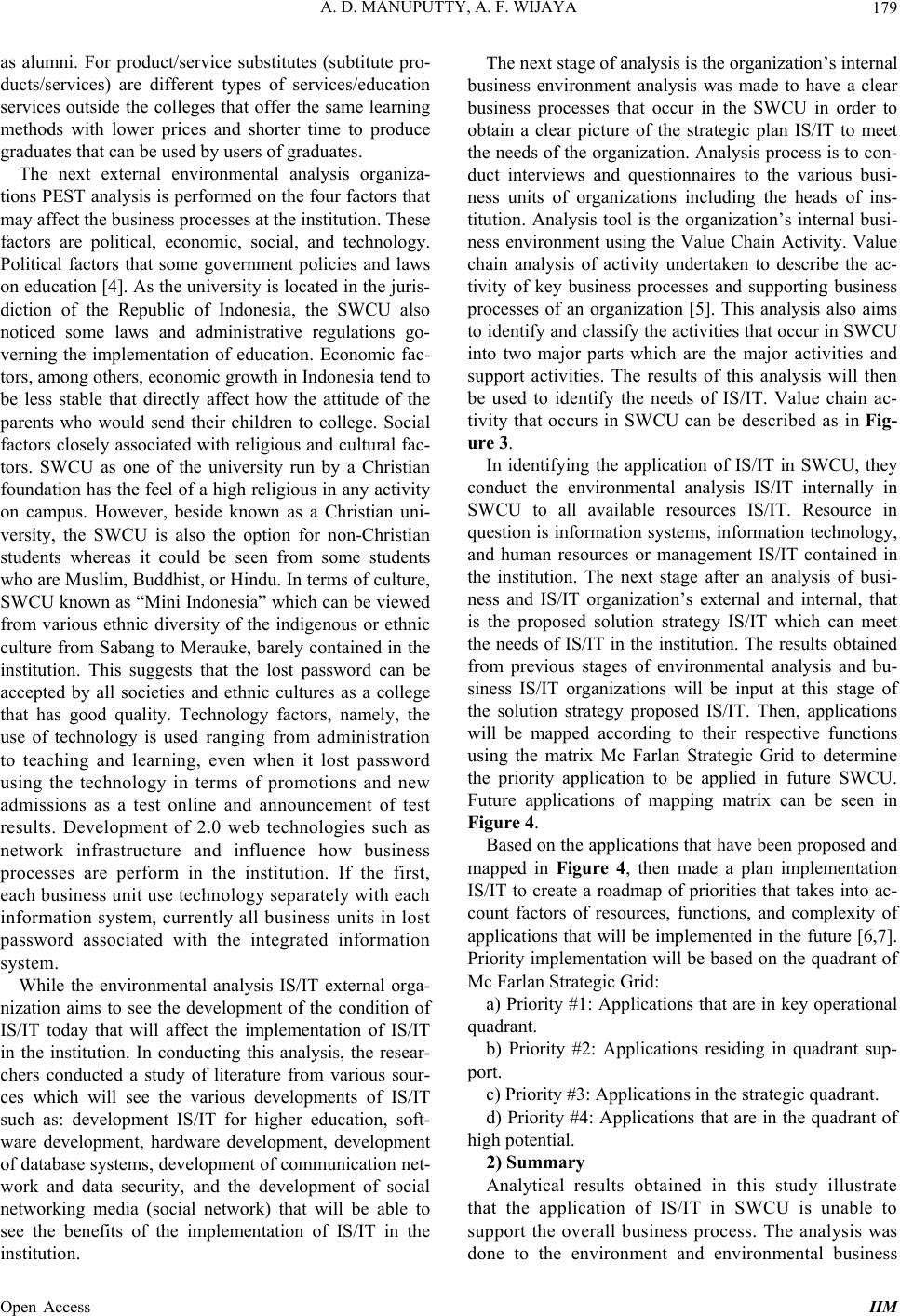 A. D. MANUPUTTY, A. F. WIJAYA Open Access IIM 179 as alumni. For product/service substitutes (subtitute pro- ducts/services) are different types of services/education services outside the colleges that offer the same learning methods with lower prices and shorter time to produce graduates that can be use d by use rs of gra dua te s. The next external environmental analysis organiza- tions PEST analysis is performed on the four factors that may affect the business processes at the institutio n. These factors are political, economic, social, and technology. Political factors that some government policies and laws on education [4]. As the university is located in the juris- diction of the Republic of Indonesia, the SWCU also noticed some laws and administrative regulations go- verning the implementation of education. Economic fac- tors, among others, economic growth in Indonesia tend to be less stable that directly affect how the attitude of the parents who would send their children to college. Social factors closely associated with religious and cultural fac- tors. SWCU as one of the university run by a Christian foundation has the feel of a high religious in any activity on campus. However, beside known as a Christian uni- versity, the SWCU is also the option for non-Christian students whereas it could be seen from some students who are Muslim, Buddhist, or Hindu. In terms of culture, SWCU known as “Mini Indonesia” which can be viewed from various ethnic diversity of the indigenous or ethnic culture from Sabang to Merauke, barely contained in the institution. This suggests that the lost password can be accepted by all societies and ethnic cultures as a college that has good quality. Technology factors, namely, the use of technology is used ranging from administration to teaching and learning, even when it lost password using the technology in terms of promotions and new admissions as a test online and announcement of test results. Development of 2.0 web technologies such as network infrastructure and influence how business processes are perform in the institution. If the first, each business unit use technology separately with each information system, currently all business units in lost password associated with the integrated information system. While the environmental analysis IS/IT external orga- nization aims to see the development of the condition of IS/IT today that will affect the implementation of IS/IT in the institution. In conducting this analysis, the resear- chers conducted a study of literature from various sour- ces which will see the various developments of IS/IT such as: development IS/IT for higher education, soft- ware development, hardware development, development of database systems, development of communication net- work and data security, and the development of social networking media (social network) that will be able to see the benefits of the implementation of IS/IT in the institution. The next stage of analysis is the organization’s internal business environment analysis was made to have a clear business processes that occur in the SWCU in order to obtain a clear picture of the strategic plan IS/IT to meet the needs of the organization. Analysis process is to con- duct interviews and questionnaires to the various busi- ness units of organizations including the heads of ins- titution. Analysis tool is the organization’s internal busi- ness environment using the Value Chain Activity. Value chain analysis of activity undertaken to describe the ac- tivity of key business processes and supporting business processes of an organization [5]. This analysis also aims to identify and classify the activ ities that occur in SWCU into two major parts which are the major activities and support activities. The results of this analysis will then be used to identify the needs of IS/IT. Value chain ac- tivity that occurs in SWCU can be described as in Fig- ure 3. In identifying the application of IS/IT in SWCU, they conduct the environmental analysis IS/IT internally in SWCU to all available resources IS/IT. Resource in question is information systems, information techno logy, and human resources or management IS/IT contained in the institution. The next stage after an analysis of busi- ness and IS/IT organization’s external and internal, that is the proposed solution strategy IS/IT which can meet the needs of IS/IT in the institution. The results obtained from previous stages of environmental analysis and bu- siness IS/IT organizations will be input at this stage of the solution strategy proposed IS/IT. Then, applications will be mapped according to their respective functions using the matrix Mc Farlan Strategic Grid to determine the priority application to be applied in future SWCU. Future applications of mapping matrix can be seen in Figure 4. Based on the applications that have been proposed and mapped in Figure 4, then made a plan implementation IS/IT to create a roadmap of priorities that takes into ac- count factors of resources, functions, and complexity of applications that will be implemented in the future [6,7]. Priority implementation will be based on the quadrant of Mc Farlan Strategic Grid: a) Priority #1: Applications that are in key operational quadrant. b) Priority #2: Applications residing in quadrant sup- port. c) Priority #3: Applications in the strategic quadrant. d) Priority #4: Applications that are in the quadrant of high pote nt i a l . 2) Summary Analytical results obtained in this study illustrate that the application of IS/IT in SWCU is unable to support the overall business process. The analysis was done to the environment and environmental business  A. D. MANUPUTTY, A. F. WIJAYA Open Access IIM 180 Figure 3. SWCU value chain activity. Figure 4. Future applications portfolio strategic grid. IS/IT external and internal in order to identify the needs of IS/IT to support business processes at the institution. Solution strategy of IS/IT focused on arranging to support the main activity in SWCU, such as promotion and new admission, education and teaching, research and community service, as well as graduation and alumni. Another strategy is to give the proposed solutions of IS/IT supporting to sustain the various activities that support the main activity, such as managing human resources, facilities and information technology, aca- demic administration, finance and accounting, labor- atories and libraries, and public polyclinics in other organizations gain a competitive advantage. TOGAF application of the methodology in the preparation of strategic planning IS/IT in SWCU provides alignment between IS/IT with the vision, mission and goals of the organization as a portfolio of solutions IS/IT based on the results of the study and analysis of the primary activities and support activities that are identified using a value chain activity. REFERENCES [1] K. Ellensyah, “Penyusunan Rencana Strategis Sistem In- formasi Berbasis Value Pada Pemerintah Daerah (Studi Kasus: Pemerintah Daerah Khusus Ibu Kota Jakarta),” 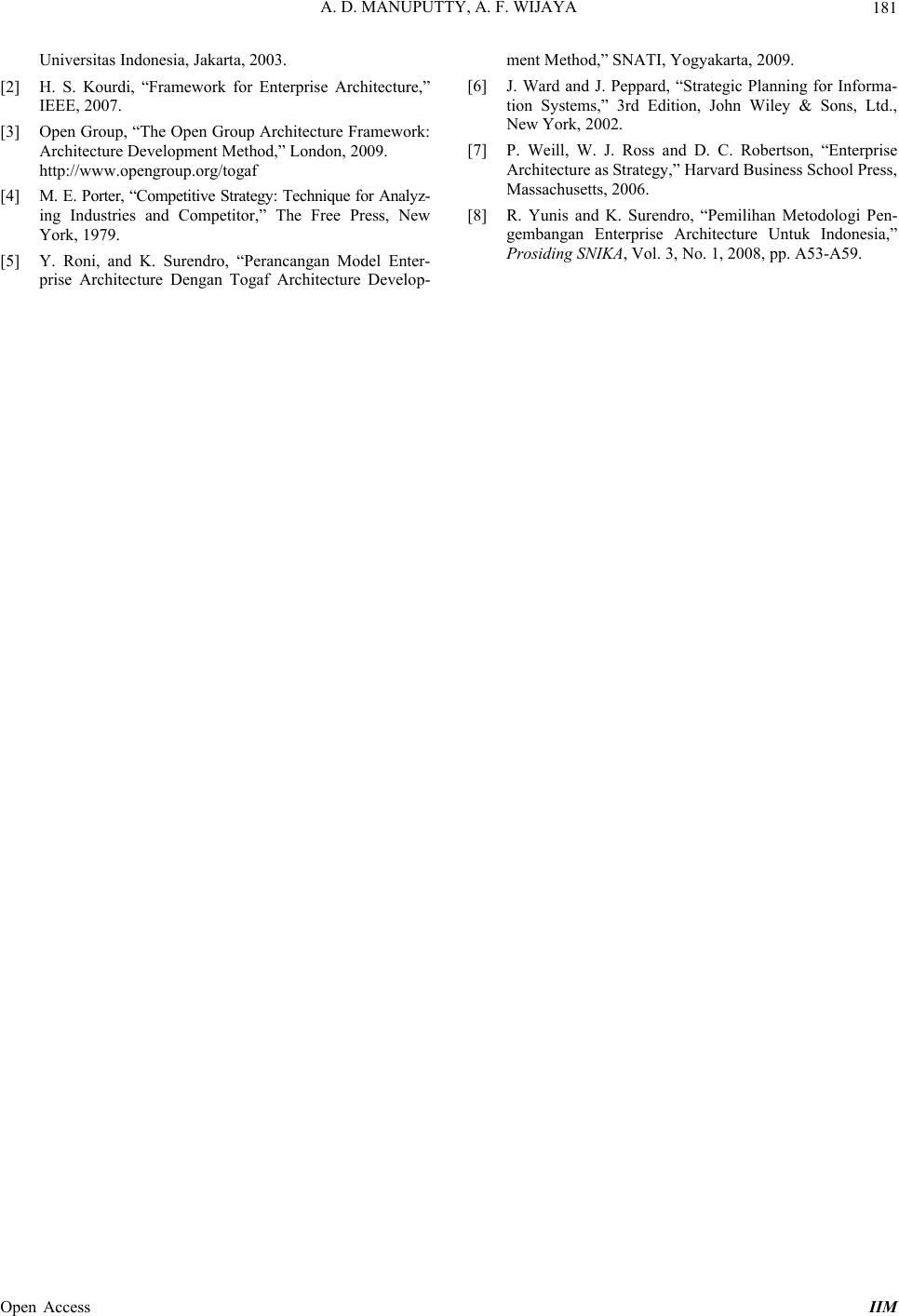 A. D. MANUPUTTY, A. F. WIJAYA Open Access IIM 181 Universitas Indonesia, Jakarta, 2003. [2] H. S. Kourdi, “Framework for Enterprise Architecture,” IEEE, 2007. [3] Open Group, “The Open Group Architecture Framework: Architecture Development Method,” London, 2009. http://www.opengroup.org/togaf [4] M. E. Porter, “Competitive Strategy: Technique for Analyz- ing Industries and Competitor,” The Free Press, New York, 1979. [5] Y. Roni, and K. Surendro, “Perancangan Model Enter- prise Architecture Dengan Togaf Architecture Develop- ment Method,” SNATI, Yogyakarta, 2009. [6] J. Ward and J. Peppard, “Strategic Planning for Informa- tion Systems,” 3rd Edition, John Wiley & Sons, Ltd., New York, 2002. [7] P. Weill, W. J. Ross and D. C. Robertson, “Enterprise Architecture as Strategy,” Harvard Business School Press, Massachusetts, 2006. [8] R. Yunis and K. Surendro, “Pemilihan Metodologi Pen- gembangan Enterprise Architecture Untuk Indonesia,” Prosiding SNIKA, Vol. 3, No. 1, 2008, pp. A53-A59. |

